Wayne C. Allen's Blog, page 14
December 26, 2021
Letting Go of Boxes
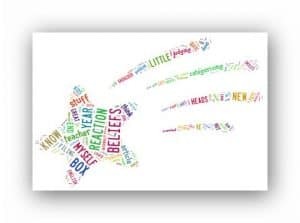
Synopsis: Letting go of boxes: we all categorize, and sometimes that’s helpful, but examining our beliefs is the mark of maturity.

Want to learn more about living a full and meaningful life?
Want to have the best relationship ever?
Check out my books
So, here we are, at the end of another year, with no clue about the next one. We’re still in the middle of the Covid thing, only now with a new variant. Only time will tell how it all goes.
We’re presently in Spain, heading back to Ontario in February. No clue how we’ll do that, but it at least ought to be interesting.
I’ve been working on a new book. Not sure about it yet. It’s on my list of principal things to do in January. Stay tuned.
Feliz años nuevo!I think that the most valuable thing to do on New Year’s Day is to state how little we know.As I think back on last New Year, I’m aware that most of what happened this year wa totally unexpected–many world events were painful to say the least, and the roller-coaster of hope to despair continues.
It doesn’t help that we are predisposed to expect stability. We do so through categorization and blame. Let’s have a look at how this works.
We assimilate raw data and somehow manage to fit it into the neat boxes implanted in our heads.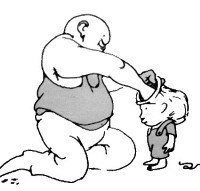 © Shel Silverstein,
© Shel Silverstein, in Playboy Magazine
Ah, those boxes! Ever since we were munchkins, we’ve been categorizing, filing, sorting. And that would be great, if we weren’t also judging.
Because we were kids, we knew nothing, and so our parents and tribes taught us “right from wrong.” This became the first of the divisions — the “this, not that’s” of our existence.
The cultural stuff is deep, and to that is added familial quirks.My dad was a Democrat, mom a Republican, and mom ruled the roost. So, I grew up, in the 50’s, following mom’s lead, and thinking the U S of A could do no wrong. Silly me.
I authored a quite jingoistic diatribe back in 1965. I had a cute English teacher who beamed at me when I impressed her, and she was a rabid Republican, so that was motivation to write an “America, love it or leave it” article for one of the papers in Buffalo. Got it published, and that got me an “A” and a squeeze on the shoulder.
By the Spring of 1968, I’d grown my hair out, and watched with glee as Lyndon Johnson stepped out of the race for president. My politics had changed–I was writing left-wing stuff and getting smiles and pats on the shoulder from a brand-new, and even cuter English student teacher.
Simple illustration, and the point isn’t really that I’m easily influenced by cute teachers (although I did marry one.)I was fervent in 1965, and equally fervent in 1968, and both “fervencies” were real and deep.
How did this happen? Well, I was able to go into the file system, and holus bolus drag my political beliefs from one box to another. I remember the struggle I had as I examined, discarded, and moved that stuff.
It’s still a struggle, this relentless self-examination, but fortunately, it’s easy to tell when I have something to work on.
Because I pride myself on my ability to reason, I am still (and often) amazed when I trigger myself.To this day, I have very little patience for conservatism, and even less for racism, so when someone says something I consider “off,” I could excuse myself for my knee-jerk, internal reaction–I want to rip their faces off. I don’t, of course, but I do want to.
Knowing this causes me to question the depth of my beliefs on this subject. Not TRUTH — DEPTH.Hint: just because you really, really believe something, doesn’t make it true!
By that, I mean: I have several groupings of beliefs that have long roots: these are beliefs I seldom examine, let alone challenge. My body, intimately connected to my brain, spouts a physical gut clench–a “That’s wrong!” reaction to divergent opinions or beliefs.
Other stuff, seemingly as fervently held, has a milder reaction.
All of this goes to show that we all are little bundles of reaction, and, left without reflection, our knee-jerk reactions are what get us into trouble.
Make a commitment to monitor yourselves for “biggies.” You know what I mean. You’re all sweaty and indignant, and you don’t know why–you just know that you are offended, self-righteous, and ready to judge.
So, have a breath.
Take the time to go inside and ask yourself,
“What deeply held belief am I triggering here?How am I offending myself?Is the belief at the base of this been examined, or has it been hanging around in here, pushing my buttons, since I was a kid?How’d I adopt that one?Is is still sensible?Then, have another breath, and see if you can go deeper, and begin to prune back the thought, and maybe even uproot it.Because, and this is the hard part, none of it is real, or true, or helpful.
It’s just the carton, the box, that you’ve been operating out of.
The goal here is NOT to create a new box, but to see what life might be like without the need to categorize. In other words, to live moment to moment, and to respond with compassion and clarity.
Now, of course, you still will react, internally.But that’s OK. Smile at yourself, and come to the party anyway! (Hey, Debashis!)
Because in the end, it’s all just a big movie, and your job is to be able to see that it is.
Facebook TwitterNovember 22, 2021
No One is Coming — Life is an Inside Job
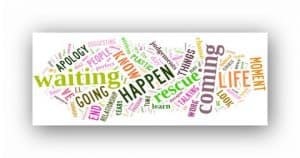
No One is Coming to rescue you from the life you have created. It’s your job to stop waiting and to begin moving in a direction you choose.
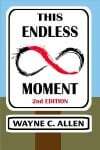
My first and most popular book, This Endless Moment. Learn to live a full and satisfying life.
 Right up until she dies, there was a little sign on my therapist’s wall, which read, in lovely calligraphy,
Right up until she dies, there was a little sign on my therapist’s wall, which read, in lovely calligraphy,“No one is coming.”
When I first met my therapist, I was a Minister. (She hung out with me anyway…) Because of my peculiar bent, my initial reading of the sign was influenced by religious statements about the second coming, (something I’ve never believed in.) I got a strong image of Jesus descending from the cloud.
I see similar beliefs in Buddhism—which is clearly a philosophy, not a religion. If you’re a good doobie and follow the Precepts, something or someone is going to keep you from any harm.
There’s a great gnashing of teeth, then, when some form of magical rescue doesn’t happen. Life happens, and the judgement that “This shouldn’t be happening to me” is where our little heads go.
I figure we’re stuck with the mess we experience until we choose to un-mess it.
“No one is coming.”Another way to explore this concept is to consider the “rescue fantasies” I and most people I know have.
A cheap and dirty example that occurred to me is actors in their 50’s getting plastic surgery, to look “young again,” yet end up looking like Jack Nicholson as “The Joker.” Plastic surgery is a hoped-for rescue from aging and death, two of the things The Buddha stumbled upon which led to his exploration of suffering and the end of suffering.
“Sadly,” the plastic surgery is plastic. Far from looking young, their faces look look stretched and tight, like if they smiled, something would tear.
And guess what? They’re still 50.A former client was on Long Term Disability for two years because someone yelled at him in a meeting. He sat at home, depressed, hiding, waiting for an apology. He thought an apology would rescue him—would cure his depression—and then he could return to work. For two years, he waited for the rescue he dreamed he deserved. For all I know he’s still waiting.
 I know you’re
I know you’reout there, somewhere
Years ago, another former client put her life on hold for eight years. She quit her job, lost her primary relationship, got hooked on pills, etc., again waiting for an apology. The crime? A co-worker suggested they share a room at a conference.
Now, before I met with her, she had grieved the proposition. The co-worker apologized, which is what she asked for. So, she sued the guy and the agency she was working for, because, she said, she wanted him to apologize differently.
I suppose I ought to add here that I’m not suggesting she shouldn’t have complained. I am suggesting that she was waiting for something that would never arrive—what she wanted was for the proposition to never have happened.
I helped her to get back to work and off the pills, but therapy ended before the court case began. For all I know, she’s still waiting.
Many people obsess about money. “If I pay off the VISA, then I’ll be happy.” As opposed to being happy now. They’re endlessly waiting for the money genie to fix fiscal stupidity.
Others are stuck in difficult relationships. They’ll do something about them, “when the kids move out,” or “when things get bad enough,” or “when I can support myself.” Of course, they aren’t doing anything now—you know, taking courses or figuring out how to support themselves. It’s all going to work out, apparently, with no effort and by magic—when their fairy godmother shows up.
She’s not coming.Another popular one is, “I’ll form the kind of relationship you are talking about, Wayne, when I find the perfect person.” Oh, brother.
The “perfect person” is not coming, either. Elegant, moment-by-moment relating is the result of continual work, not fantasy.It’s tough, life, especially when you put your life on hold, and desperately wait for all of the external circumstances line up like ducks in a row, until everyone behaves, until all the pieces fit, and there are no more problems. “Boy, when all that happens, then I’ll have a great life.”
I’ve got news. No you won’t. Because none of that is going to happen. Life will continue to provide challenges, and the rest of the people on the planet are not going to change so you can finally get on with things.
All of that external stuff doesn’t really exist anyway, other than as a figment of your imagination. So waiting for an outside rescue is foolish in the extreme. The game is always and only in your head.
The truth is, “No one is coming.”We’ve been handed a block of time, which is also a bit of a conundrum, because all we can know is when it began. The other end, the slippery end, comes when we die. Death happens whenever it shows up, and that moment could be tomorrow.
None of us have all the time in the world to learn to live our lives with elegance and presence. We’ve just got now. This minute. To simply be who we are.This block of time is a precious thing. It’s the place where everything happens, one moment at a time. Here and now, we are encouraged to be real, communicate, have our experiences, feel our feelings, make our judgements (—no way to get past this one. But, of course, we don’t have to act on our judgements, now do we??)
It’s about healing rifts here and now, not sometime, when everything is perfect. It’s about taking risks, making changes gently, right now—because there’s never going to be “just the right moment.” There are just moments, like this one; you choose how you see it and use it.
[image error]Or, as Yogi Berra famously said,
“When you reach a fork in the road, take it.”
Putting off the hard (or even the easy) decisions of life, on the assumption that clarity is down the road, is a sure recipe for waiting.
Like the play, “Waiting for Godot .” Each day, they wait, and talk about what wonderful things will happen when Godot finally arrives. They wait. They leave. They come back the next day. They wait. And talk of all the wonderful things they’ll accomplish when Godot gets there. They wait.
He never arrives, because he’s not coming.
So, what are you waiting for?
Facebook TwitterOctober 23, 2021
9 Tools for Relating
Here are 9 ideas to improve any relationship, taken from my book, The. Best. Relationship. Ever.
The StructureIt is our belief that self-knowing happens best in your Primary Relationship. This relationship has as its keys: elegant communication, vulnerability, (the willingness to open up) openness, (the willingness to take in) and intimacy (making full, honest contact.)
Through dialogue, baseline parameters are set in the following two areas:
Engaged Communication – this is the minimum requirement – that there be open, honest, and intimate dialogue. We propose following the basic Communication Model described below – using it to dig deeply, and learn more of both “self” and “partner.
Engaged Contact – after the above is established, the couple creates levels of physical contact. It’s essential to create flexible boundaries in this area, and to immediately discuss areas of confusion / discomfort.
Within the “safe hands” of Engaged, Intimate Relating anything is possible. We have the opportunity to trust, to open, to be vulnerable, and especially, to explore our own darkness, in the presence of a partner who is a curious, active participant.
The following 9 Tools form the basis for what is to follow – we believe that this is the only way to achieve personal and relational contentment!
As I noted earlier, this book is seemingly about relationships, but it’s actually a self-development book. Self-work is the only way to engage with life, with others, and with our way of being. Our relationships shift precisely as much as we, as individuals, shift.
What follows are brief descriptions of the 9 ToolsI’ll flesh them out in later chapters of this book. For now, let me suggest some understandings for each of these points, and how each applies to personal living and Elegant, Intimate Relating.
1. Total HonestyIt’s impossible to have a rich and meaningful relationship while keeping secrets (“The flaw of omission,”) or while lying (“The flaw of commission.”)
Many are the excuses for dishonesty:
“I’m an adult and I have a right to privacy.”“(S)he might get mad if I was honest about everything.”“I just want to be me – no need to talk about it.”“White lies aren’t harmful.”Being dishonest is a mini-betrayal. It’s an indicator that you don’t trust your partner enough to share what’s up for you, and are embarrassed about your actions.
We advocate Total Honesty. And yes, sometimes being totally honest is scary, or might lead to a protracted discussion. But the truth is this: almost everyone who lies gets caught.
Personal: “It is my intention to tell the truth, all the time. I recognize that how “deeply I go” depends on who I’m interacting with, but I will answer truthfully, and be direct and clear with everyone.”
Relational: “From this point on, my policy with you is Total Honesty. I’ll let you know what I am thinking, how I am deciding, and what I am doing. I am not doing this for permission, but rather to foster intimacy and deepen our relationship. I invite you to do the same.”
2. Being PresentPresence is about 2 things:
being in the moment, the Now, andbeing focussed on what you are doing.Most of us live our lives either in our heads (story-telling), or detached from our selves (numb.) Sort of ghosts, walking.
Being in the Now helps us to stay focussed on the immediate situation, while adding little or no drama through storytelling or future projections. This kind of presence allows us to deal with each situation as it occurs.
Personal: “I just tuned out and ended up imagining all kinds of stories that have nothing to do with the situation before me. I’ll just have a breath and come back to the present moment.”
Relational: “As I listened to you, I caught myself telling myself familiar stories about how hard-done-by I am. I recognize that my stories have nothing to do with you or the situation, so I’m filling you in as a way to come back to the Here and Now.”
3. Being self-responsibleSelf-responsibility is not about self-blame. Rather, it’s about claiming ownership of our lives.
It is ‘normal’ to push responsibility away. Most are willing to take credit for success, and want to point a finger elsewhere when confronted with things judged ‘wrong’ or ‘bad.’
Self-responsibility is simple – “I am the author of all of my life, as I view it right now.” This is not a denial that ‘bad’ things happen,” and that others may even intend us harm. It’s to say that nothing compels us to act in ways that are non-helpful.
Personal: “This is going on right now, and I am making myself uncomfortable. Nevertheless, I am in this situation because of my choices. I can, at any time, choose differently.”
Relational: “I am choosing to upset myself over the way I perceive our relationship. Therefore, I will own my responsibility for having gotten myself into the state I am in, and I will decide what I will do next.”
4. Speaking clearly — Use dialogue to know yourselfWe teach a specific Communication Model, and do so because most people are lousy communicators. Rather than use communication to deepen their self-understanding, they use it to justify their “hardened” behaviour and thinking, while proving others wrong. Or, they use communication to blame.
As soon as you harden a thought into a belief, you become less flexible and therefore less teachable, as you shift to, “I know, and I am right.”
Dialogue, on the other hand, is about exploring our personal beliefs as we listen to feedback. It is essential to bear in mind that this exploration is only possible if you choose to hold your beliefs and “demands” loosely.
Personal: “Here is what I see, here is what I feel in my body, and here are the stories I am telling myself.”
Relational: “I want to share with you my provisional guesses about what I see happening right now. I’m wondering about your perspectives on my stories – as I listen to you stating your perspectives on my story, I will not be defensive. I will listen with openness, and then clarify my intentions.”
5. Being Curious – and NODingWhen we live our lives up in our heads, dwelling on the past and fearing the future, we think that our version of misery is reality. We get locked into thought-loops. We exit the moment, shut down by tightening our bodies, and dwell in “Never-Never Land.” The “Never” part is actually, “My life will never be different, and I’ll never be able to change.”
Curiosity is the opposite of self-righteousness and blame. If you pay attention, you’ll notice that you are often confused about your own motivations and actions. How then, could you ever think you had a clue about what’s up for others?
Personal: “I am drifting into past and future again. What is actually happening right now? Is anything required of me, right now? What does my body want to do? What would happen if I stopped telling myself stores, sat down, and had a breath?”
Relational: “When I confront situations like this one, I get caught in a mind loop… I’m wondering if you would have time to listen to my description, and then I’d like to hear about how you get yourself out of your mind-loops.”
6. Letting go of Drama and StorytellingObviously, we have a story about ourselves – one we are anxious to tell others, and one we believe is ‘true.’ The story contains fragments of our biography, and mostly consists of examples that support our victim-story. One of the great leaps of self-responsibility is the understanding that our stories are “just stories.”
We have much invested in our life-story, and also give much energy to defending everything that props it up. We move past this by allowing ourselves to question both the accuracy and validity of the stories we are telling.
Letting go of drama is similar. Because we spend so much time talking to ourselves, about ourselves, we have a tendency to see ourselves as the centre of everything. Now, certainly, we are the centre of our own universe and experience – we’re just not the centre of anything else. Despite our desire, no one is going to make us the centre of their universe. And the stuff that happens is the stuff that happens. It’s not happening to you personally.
Personal: “Here is what is actually happening right now. I notice the story I’m struggling to tell, where I’m a poor, helpless victim, and I choose, this time, in this moment, to let that story go. In this moment, I’ll be present and aware, and see what, if anything, is required of me.”
Relational: “So, I notice that I’m hearing you speak, and I’m seeing what you’re doing, and I’m telling myself all kinds of stories about how you are punishing me, or trying to manipulate me. I notice that I am creating these stories out of my thought-loops, and I want to acknowledge that I’m doing this. I will now let go, and return to being open and curious.”
7. Being FlexibleThe lynch-pin for Elegant, Intimate Relating is flexibility.
I may have spent years developing my relating style, but I also have the power, each time, to change what I am doing. In other words, I have a choice, each time, to do things differently, or to go back to habitual behaviour.
Integrity plays a big part here.
While I know that I have complete freedom of expression, I also begin to look at the consequences (results) of my actions. I evaluate the result I am getting against what I have committed to – Elegant, Intimate Relating – and only do what deepens my relating.
This is flexibility.
Personal: “Here I go again, doing the very things that endlessly land me in the soup. This is who I am, but right now, I can transform this pattern by stopping, having a breath, and making another choice.”
Relational: “Wow, there I go again, blaming you for how I am feeling. I accept that I do this, and am pleasing myself that I caught myself this time. Give me a second to have a breath, and then I’ll shift back to dialogue.”
8. Feeling Your FeelingsFeelings have a bad reputation. People resist their ‘negative’ feelings – are caught in judgement – endlessly assigning “good / bad, right / wrong” categories to everything.
Essential to Elegant, Intimate Relating is total acceptance of each and every feeling.
As we meditate, for example, what becomes clear is that thoughts and feelings flow through us like clouds crossing the sky. If we latch on to the feeling / thought, we create suffering for ourselves. If we express the thought or feeling, we can let it go.
There are no ‘bad’ feelings – there are, however, non-useful ways to express them. So, we accept and transform each feeling by expressing it with awareness.
Personal: “I am aware of my anger, my boredom, my sexuality and sensuality, my tightness, my shutting down – all of my feelings. I accept that these feelings pass through me – they are not me, but rather expressions of my moment-by-moment experience. I therefore choose to express them safely and thoroughly.”
Relational: “I’m noticing that [the current feelings] are coming up for me, and I’m wondering if you’d be interested in helping me to fully experience and express them, so that I can learn their lesson and then move on to whatever is next.” (see below, Expressing your Feelings)
9. Exploring Sensuality and SexualityMost adults have “issues” around open, honest, and deep revelation and expression of matters sexual. The discomfort is deep-seated – stretching back to childhood.
Because of our discomfort, we talk in euphemisms and hints. We tend to only get part of what we are looking for, and might be unclear about what we want.
We also have desires and attractions for others, and are uncomfortable both with the feelings themselves, and with sharing them. We avoid conversations about our “turn-ons,” out of confusion, fear, and to avoid jealousy. We end up more confused, blocked, and wary.
Personal: “I am doing some serious work exploring my sensual and sexual nature. I am going to use clear language to describe who I am and what I want sexually, and I am going to create “Vulnerability Projects” to explore areas I am curious about / scare myself over.”
Relational: “I am noticing that I have some issues as regards my sensuality / sexuality. I am exploring these issues, and I will keep you informed about what I am discovering, as well as invite you to work on some of this with me. I also commit to keeping you updated on people I am relating with, and letting you know who I find attractive, chargy, etc.”
Facebook TwitterSeptember 18, 2021
Elegant, Intimate Relating is the key
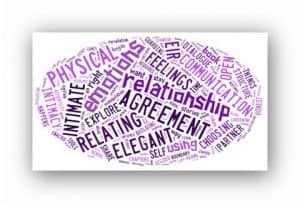
Synopsis: There is a structure to excellent partnerships, which we call Elegant, Intimate Relating

Want to learn more about living a full and meaningful life?
Want to have the best relationship ever?
Check out my books

Steps for Elegant, Intimate Relating
Last article, I made a comment or two about relating, and mentioned that this time I’d explore communication. Then, I thought, it might be fun to share with you the ground floor for building a creative and functioning relationship.
As it turns out, I wrote a book about this not so long ago, so I decided to share a chapter with you, entitled, Elegant, Intimate Relating (EIR). Taken from my book, The. Best. Relationship. Ever., which is available as a paperback and as an e‑book from online booksellers.
EIR is a structure for living deeply and fully with othersWith EIR, nothing is taken for granted. Elegant, Intimate Relating requires the active participation of two separate and distinct beings, both of whom are dedicated to rigorous self-exploration. Each is using the relationship to gain depth and breadth of knowledge about the only thing each can know: themselves.
Elegant, Intimate Relating is enacted at the direct meeting of two whole persons. I call this “meeting at the boundary” – I am still I, you are still you, and we meet to explore, to reveal, to be open and vulnerable through honest revelation.
The revelation has to be authenticIn EIR, you are choosing to be transparent with your partner.
EIR is not about saying nice things, not about manipulating your partner to see or do things your way. Nor is it about hiding the fact that you have a range of feelings and emotions “in there.” Transparent authenticity is choosing to let yourself be seen – as you are, and how you are.
Elegant, Intimate Relating happens only in the Here and NowIt’s about true vulnerability. Vulnerability happens as I choose to reveal my internal experience and intentions, as opposed to using them as a basis for manipulation.
Vulnerability is expressed by letting out what is going on for you, right now, with no excuses. This is me, right now. And part of “me, right now,” is the emotion that is happening inside of me. Not descriptions of the emotions, not blaming someone for the emotions, but rather the emotions themselves.
Once you “get this,” you’ll also notice that emotions are fleeting. I can be sad, then bored, then weepy, then laugh-filled, then have the feeling of “nothing much,” but only if I do not cling to my story, a.k.a. thinking too much.

Being unguarded
Un-guarding yourself means being willing to own and share your in-the-moment reality, without filtering. Being un-guarded means speaking your truth – the truth that comes from “Here is what is so for me…”
The point of Elegant, Intimate Relating is to clear the decks so that you can shift what is not working. Letting go of guardedness gives us the opportunity to see how we are structuring our stories to stay stuck.
From there, you choose to do something new and refreshing. It’s not meant as an exercise in self-aggrandizement, and emphatically is not a game to stay stuck, while pretending to “get it.”
Un-guarding means loosening the filters, and expressing yourself as you are, with focus and clarity.
The Beginning of Elegant, Intimate RelatingThe Tools section of the book describes the “how” of an EIR. Here’s the “what.” The following is from my book, The. Best. Relationship. Ever.
Engaged Intimacy, first of all, requires a dialogue agreement
Let me whip out my crystal ball and declare that your past relationship failures were caused by poor, faulty, or non-existent verbal communication. Other problems were: non-verbal communication, magical thinking, lack of physical intimacy, and lack of self-responsibility.We are going to establish a dialogue agreement, and then discuss how to enact it.
The Dialogue Agreement
“I have decided to commit myself to open, honest, and vulnerable communication. I will use a Communication Model, self-responsible language, and will keep my boundaries open and flexible. I will be in dialogue with you for no less than 30 minutes per day, and when issues cannot be resolved within that time-frame, I agree to make as much time as necessary to resolve the issue, with no compromise. I commit to keep you totally informed about what is going on for me: my stories, my games, my evasions. I will keep you completely informed about my feelings, my attractions, and my other relationships. I do so not for permission, but to facilitate clarity.”
The Physical Contact Agreement
Given that we’re discussing your Primary Relationship, physical contact is a given. We’ve noted that Engaged Intimacy is also available for other relationships. I think it’s important to establish physical parameters, even within the Primary Relationship. Thus:
“I commit to using physical contact as another way of exploring my emotions, blockages, and my connection with you. I accept that physical contact is an end unto itself – that it is not primarily a means to having sex. I will be open and honest about my need for emotional expression, and will use safe methods of expressing my emotions thoroughly. I will ask for what I want as regards physical contact, recognizing that what I want “now,” may not be what I want “later.” I am open to expressing whatever feelings arise through physical contact, will stay focussed on myself, and will feel my feelings fully.”
This becomes the framework for Engaged Intimacy
From this baseline, which you are free to add to, but not reduce, we begin the process of building intimacy and presence.
I would suggest that you look carefully at the above Agreements, and then read through the “Tools” chapters to follow. Once you have a grasp on how this all fits together, sit with your partner, begin right here with the Agreements, and structure your own agreements.
You will want to write out what you are agreeing to, and then sign it. Remember: all you can agree to is what you will do. This is not a conditional, “If you do this, then I’ll do that” kind of agreement. You are making the commitment to yourself to act in a certain way, while in your partner’s presence. I’ll be reminding you of that as we go along.
Facebook TwitterAugust 25, 2021
The Care and Feeding of Relationships
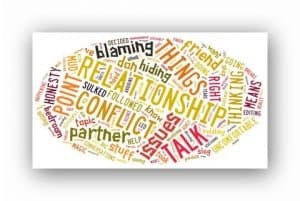
Synopsis: relationships need maintenance. There’s no magic–there’s commitment to a way of relating

Want to learn more about living a full and meaningful life?
Want to have the best relationship ever?
Check out my books
 There is certainly a better way to make your point…
There is certainly a better way to make your point…Prior to Covid, I was sitting on the rancho at our place in Costa Rica the other day, talking with a new friend, and got to thinking about my books, specifically Living Life in Growing Orbits.
Before we came to Costa Rica that time, relationships stuff involving several of our friends was in the foreground.One topic was “honesty.” As in, a friend of ours wasn’t being totally honest with her partner. The issue was not a big one, but her desire for secrecy was ringing warning bells for me.
That conversation has stayed on my mind, especially after I see her again. And that led me to decide to write a couple of articles on relationships.
Background: I know this young woman very well. I remember back to her previous “big relationship,” and I talked with her a lot when it ended.She described the following “conflict process”:
You think?
We’d start to argue, and I don’t like arguing, so I’d go curl up in the bedroom while he sulked on the couch. Sometimes we’d not talk for days. Then one or the other of us would make an effort to be nice, and pretty soon, things were back to normal.
But I guess they weren’t, because the break-up, according to him, was due to all the unresolved issues.”
Here’s how her resistance to talking applies to what’s happening in her current relationship: the thing she’s avoiding telling him has the potential to have some emotion connected to it, and she doesn’t like dealing with negative emotions.
But this time, she’s not hiding in her bedroom. She’s hiding the information.
Now, I’ve heard it all on the topic or whether honesty is required in relationships. Many are the justifications for “secrets.”
Typically, they boil down to, “I have the right to my privacy! Why should I have to talk about stuff that I’m uncomfortable talking about?”
 You mean I can’t just phone it in???
You mean I can’t just phone it in???I have a solution! If you don’t want to talk things through, don’t bother getting into a relationship!
I don’t “believe” in secrets in relationships. And yes, that means there are going to be some uncomfortable conversations.
But really, the issue here is “about” communication, pure and simple.Darbella and I made a pact, back when were were dating, about both honesty (we agreed on total honesty) and conflict resolution. (We agreed to work our issues through to our complete satisfaction, no matter how long it took. The longest one took 18 hours. Straight. OK. We took pee breaks…  )
)
The odd piece? After nearly 40 years of doing this, it’s still difficult.
When we hit a conflict point, I go to arrogant sulkiness, and Dar goes to defensiveness and deflecting. I revert to six, she to 8. I want her to admit I’m right and to do things my way, she wants me to admit that whatever she did pales in comparison to what I did.
That’s our opening gambit.Needless to say, from that place, nothing is going to get resolved.
We’re not the only ones with faulty opening gambits:
Our friend hid in her room while her partner hid in the living room.Another couple, no longer married: she yelled and name called, and he sulked and sighed in silence. After 10 years, he presented her with a list of everything she’d done wrong (he, of course, thought he was innocent of any wrongdoing,) and ended things.Others just finger-point, blame the other, and stop when the fighting or silence is overwhelming. Nothing is discussed, no therapy is begun and then followed through with.Some people think that the “right” relationship has no conflict. Magical thinking prevails: “If I am with the right partner, we won’t have issues, fight, get angry. Since we are in conflict, I need to change partners.”Well, phooey.
Pay attention, for Pete’s sake.Our young friend knows that what she does that makes dialogue impossible. She hides in her room, or hides the truth, and when she emerges, she buries the issue that she didn’t want to talk about.
Why? Because she makes herself uncomfortable over conflict. She wants it to go away. By itself.
Here’s a hint. None of us like conflict. However, if you choose to live with someone, there will be some. Conflict. Because fundamentally we each see the world differently.
So, what to do?Well, in my / our case, we run through the sulking / finger pointing stuff as rapidly as we can. Then, we sit down, and follow the Communication Model, and take whatever time is necessary to come to a 100% agreement.
The nice thing about adopting a model, as well as making a commitment to talk things through even though we’d really rather not, is that the drama drains out of the situation pretty quickly.
Once we get over blaming, it’s pretty easy to own our own stuff, and to find areas of agreement that can be built upon.
You make this impossible if you refuse to get over blaming your partner for what you are feeling / doing.One person we know, in all the time we’ve known her, has never, not even once, acknowledged her role in her issues with her husband and kids. It’s always, “They’re not doing it right!”
We point out (she asks us for help, which she then always ignores…) her language, and ask her what she can do differently. She looks blank, then says, “You don’t understand. It’s him / them, not me!”
Yikes.
Self responsibility means owning my side of everything that’s happening in my relationship. It’s not taking the easy way out and blaming my partner, or uttering inanities such as “He didn’t try hard enough, and now it’s too little, too late.”
 You mean… I have to do something to get out of this???Relating is a slog.
You mean… I have to do something to get out of this???Relating is a slog.A fun one, but a slog. It’s a slog because, like walking in mud, it’s slow going when things are “up.” But avoidance, blaming, hiding in your bedroom–not helpful.
The only way to get out of mud is to walk out. The helicopter is not coming, and blaming the mud or the rain likely won’t help either.
Next time, more on how to communicate.
Facebook TwitterAugust 15, 2021
Dropping Duality by learning flexibility
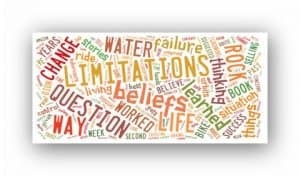
Dropping Duality — On “Success” and “Failure” — illusions, both. The stories we tall ourselves keep us stuck. Until we notice exceptions, which point us in the direction we want to go.

Want to learn more about living a full and meaningful life?
Check out my books
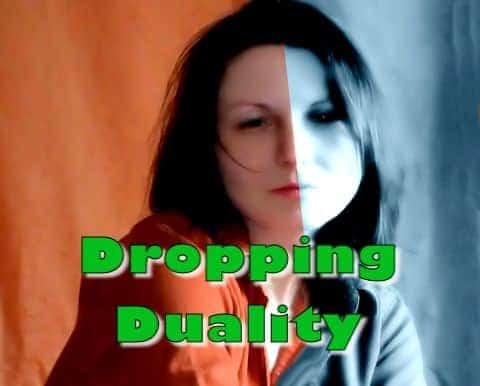 On Dropping Duality — “Success” and “Failure”
On Dropping Duality — “Success” and “Failure”It ought to be apparent that things like success and failure, what we can or can’t do, etc. are not “fixed entities,” but rather beliefs that have no substantiality. We do well to let go of such thinking.
Here’s a question raised by a reader, concerning limitations. I love questions, so feel free to e‑mail me any time!“I’d be interested in what you might have to say about personal limitations and failure. How do we acknowledge and accept them in a positive manner? How do we act within our limits, yet reach beyond our grasp? There seems an inherent contradiction between “setting your mind on anything” and the real, universe-given limitations that we are born with. What does failure mean with respect to all of that?”
One of my books is called, Living Life in Growing Orbits, and the way it works is that there are weekly concepts, and then daily exercises. You follow along, get a sense of the topic for the week, and then do what’s suggested, every day — for a year.
It starts out with Rock beliefs. (click to read a sample) These are the “ancient” beliefs we all have, but are often unaware of.
We nevertheless operate out of those beliefs, and often on auto-pilot. This is why we keep getting into messes that seem different on the surface… but with a little examination, we see “Same old, same old.”
The second week, I introduce:
Water Situations (click to read a sample)Water Situations are things in our life that fly in the face of what we believe to be true — our Rock (or fixed) Beliefs. We do something, and get results we weren’t expecting.
Normally, we write off the exception, to our detriment.A simple example: prior to learning to ride a bike, we had a Rock belief that we either “can’t” or “don’t know how.” Most of us, when trying to learn, spent many minutes or hours falling over and skinning our knees.
Then, one odd and miraculous day, we stayed upright, and drove around the block, and had a Water experience. “I can ride a bike!” (Until you realize no one taught you to stop, and the only way to do so is to fall over… my dad yelling “Hit the brakes!” not exactly cutting it…)
So, then what happens?
The Rock belief (can’t ride a bike) gets overridden by the Water experience (can ride a bike.) The Water experience becomes the new Rock belief (most of us who have learned to ride a bike also assume we still can, even after years of not.)
When we were growing up, everything was hard, until it wasn’t. Bike riding, running, school, dating. Lots and lots of stuff. We just tucked our heads and got on with itThen, we grew up — and in a sense learned about dropping dualityWe forget this “hardwired-in” pattern of learning: can’t, practice, can. Our Rock beliefs are lodged in our heads (Rock head?) and dynamite can’t dislodge them. We become quite smug in our denial of our ability to change.
Let’s remember: when we were growing up, failure was called practice .We didn’t define ourselves by what we couldn’t do. Without much thought, we just figured things out. We didn’t limit ourselves unnecessarily.
I used to toss in the caveat that we’re not talking physical limitations here. Sure, wanting to be able to “leap tall buildings in a single bound” doesn’t mean we can. I’d point to my height and declare that I could never be a basketball player.
But then I saw a video of some kid who is under 5 feet tall and plays basketball extraordinarily well. I didn’t believe short people could play… and now I do… little people can play basketball!
In a contest between rock and water, water always wins
We want to understand that we are limited by our beliefs, not by outside forces. Then, we understand that the solution to the limitation is, first, a change of belief, AND then a change in behavior.
I know. It’s not easy to admit that we choose each and every one of our behaviours, as well as how we limit ourselves.We choose what we think we can do, and emphatically we choose what we will not do. The only way past this, (and why the first two weeks of Living Life in Growing Orbits is all about listing beliefs) is to explore our beliefs with a critical eye.
As we unearth and “verbalize” what we’ve been told by others, and as we “verbalize” what we’ve done with those rules, we get the opportunity to decide what is helpful, as opposed to what was helpful for someone else.
As we listen to ourselves, we hear our own Rock Beliefs.“No one will ever love me.” “All they want me for is sex.” “I’ll never figure out what I’m passionate about.” “I can’t let go… lose control.” “I’m not (smart enough, rich enough, connected enough) to do what I want.”Out they tumble.Rock, limiting beliefs are easy to find — they are always expressed through some version of, “There’s nothing I can do about that. It’s just how I am, (or it is.)” or, “It’s my parent’s fault. They made me the way I am.”
It’s as if we believe we are compelled — forced — made to — behave in a certain way, and no other.
I once worked an artist who told me that he was “a procrastinator.” No choice. He couldn’t get to what he’d agreed to do for me, as he’d procrastinated about a couple of other things, which were stacked up ahead of mine.
I was just supposed to wait.Instead, I offered money and a deadline — and connected the two. I guess no one had done that with him before. He got his work to me one day late. Not bad.
Every intervening e‑mail, though, reiterated how far behind he was, and how he hadn’t remembered committing to a deadline. And yet, he got the job done.
So, it begs the question: who makes him procrastinate, and will he choose to get past it?Water stories remind us that nothing is graven in stone.
As we look at these “contrary” stories, we can make the leap that anything that gets in our way originates in our own perception.
Rather than proclaiming stuck-ness, we can change our approach to the situation, and also change the rule(s) that got us messed up in the first place.
Just like the procrastinator who now has one Water story of being on time.
So, what does this have to do with the question I received?The question is all about how one chooses to define the situations confronted. Here’s an example:I once counselled a 17-year-old who had been abused. After the event, she thought, “Because of that, I’ll never be able to trust anyone again.”
For the five years after her experience, her Rock belief was set in the cement of “never.” She missed tons of exceptions, always noticed things that supported her belief.
I helped her to change her definition of the abuse to “a situation I experienced, and worked my way through.” She learned to drop blaming the abuse for everything that didn’t work out in her life.
And she learned to trust again by… wait for it… trusting.
We’ve all been trained from birth to label the events of life as either “success” or “failure.” I’m not so sure that life is quite that clear cut. Learning this is what I mean by dropping dualityI think that my relationship with Darbella is pretty much the most elegant relationship I see around me. I say because I’ve been hanging out with Dar since 1982.
On the other hand, my marriage to Dar is my third.
Now, here’s the question — were my first to marriages failures? Of course not. Unless I choose to view them that way.
Prior to age 32 (when my second marriage ended,) I was dumber than a stump when it came to relationships. My motivations for being in relationship were cloudy. I also thought it was my god-given right to insist on everything going my way.
Then, I “got it.”
Out of my experience with the end of my second marriage came “The List of 50,” which is now a full length book called Find Your Perfect Partner.
I learned that I had begun past relationships on the basis of how the person looked in a tube top. I’d meet someone, and think, “Well, she’s not whom I want, but I can change her.”
I realized that if I put energy into thinking about what I really wanted in a partner or a friend, I’d have a much better chance of finding them.
This was the lesson of my second marriage.Perhaps, then, the only “failure” is when I do not learn from an experience, and therefore end up repeating it. That being said, I also am the sum total of all of my experiences.
The real question is, am I stuck, or am I changing what isn’t working?
A second part of the writer’s question concerns limitations.I’d like to suggest the idea of “expanding possibilities.” I am suggesting that, far from there being limited choices for your life, there are endless other ways of being.
The limitations we confront are “self-made” constructions, bolstered by the stories we tell ourselves. Or, as the expression goes, “Argue for your limitations and they are yours.”
We have the potential, in dialogue, to examine and re-examine the stories of our life. We can listen to what we tell ourselves, how we describe our situation, and we can begin to understand that, far from seeing our lives objectively, we see them through our beliefs / stories.
If we do not choose to confront our beliefs, we will find ourselves living self-fulfilling prophecies that are limiting and limited in the extreme.
I believe that all limitations are self-imposed.Sure, some things are beyond my control — that would be all the stuff outside of me. We walk in tension between the things we can control (our thoughts, beliefs, behaviours,) and what we can’t (what happened in the past, the behaviour and beliefs of others, “circumstances.”)
The wise person is he or she that can narrow their focus while broadening their horizon, seeing, for themselves, both what is possible and what is worth the effort.It is so, especially in the West, that we can have pretty much whatever we want. We’ve taken that to mean acquisition of things as a measure of worth.
The “system” supports such thinking.
Or, you can choose to determine your “success” based on personal satisfaction with a job well done.
So, let’s say I want to be a “best selling author.” Hmm. There’s a difficulty in thinking that way.
I can control the “author” part. The “best selling” is determined by the public. I would be better off setting my sights on being an “above average,” then “excellent” writer.
Having achieved the best I can achieve, given my skill set, I will either be, or not be, “best selling.”
Take van Gogh. If memory serves, he sold 2 or 3 paintings in his life. Question. Did he “succeed” or “fail” as an artist? Hmm.
The question is one of realistic expectations, coupled with success measured not on comparisons with others, but on comparisons with myself.
Facebook TwitterJuly 31, 2021
Mind, Meditation, Suffering, Letting Go
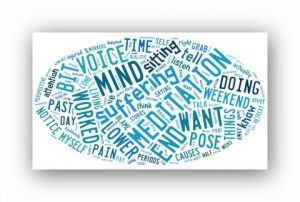
Mind, Meditation, Suffering, Letting Go — it’s difficult to let go of our own stories, especially about how we suffer. Here are some hints.
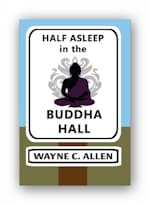
Looking for more on this topic? Check out my book, Half Asleep in the Buddha Hall.
Back around the turn of the century, Darbella and I developed a holistic programme to help injured workers in Ontario.
If you want to learn what we taught the participants, there’s a course available called “Finding Your Flexibility.”
The first week, I sarted by saying,
I want to unpack this a bit, and offer you some experiments.“Throughout the next weeks, I want you to understand one thing. Pain is a part of living. Suffering is optional.”
The insight that led to the Buddha’s awakening was his realization of the trouble we cause ourselves by our unconscious living.
We often run on auto-pilot, unaware of what we are saying or doing.
The saying and doing part is not the issue. It’s the auto-pilot that causes us to waste our lives caught in a dream.
The First StepZazen, or sitting meditation, is not a means to an end. It is the beginning, the path, and the end.

Meditation causes us to see, likely for the first time, the workings of our body and mind. As we “just sit there,” it becomes painfully apparent that our minds never shut up.
Meditation is not about an empty mind — that is impossible — but rather helps us to learn to let go of our mind’s games.
Here’s how it works.I have a dicey lower back. Knock wood, I haven’t thrown it out in a long time, but let me tell you, I’ve been flat on the floor, in spasms, unable to get up, more often than I can count.
I therefore pay attention to my lower back, lift things carefully, bracing myself when I sneeze and cough, etc.
Darbella and I did Iyengar Yoga for 6 years, and I continue to do stretches and lift weights. I still notice that my lower back is tight and sore a lot, part of which is attributable to getting old… er.
When I do tweak my back, what I feel is pain. A triggering, warning shot across the bow, so to speak.
Because I spend time paying attention to myself, I notice two things simultaneously, and then add in a third.
First, I notice the “grab.” (I notice the body sensation of “pre-pain.”)
Second, almost immediately, my mind kicks in, thusly:
“Holy crap! Your back just blew out! You’re going to be on the floor, you’ll never get up again! Do something, now!”
The last thought is (or could be) the killer.
From past experience, I “know” that if I just crash down to the floor, in all likelihood, my back will be a mess.
Everything my mind is telling me is “suffering talk” designed to take me exactly where I do not want to go. My mind “just knows” that my back is toast, and it screams at me to drop to the floor.
Here’s the third part, which I added on: I hear my internal voice, smile, and stretch a bit, while breathing.
Why? Because my back isn’t actually hurting. It’s warning me to take care.
After some stretching, I very slowly lower myself to the floor.Result? I lay there, wiggle my butt around, and low and behold, nothing.
The muscles of my lower back feel sore — like they’ve been exercised. I get back up, with not much pain. And no suffering.
The suffering part is this: I’m toast. My back will be like this forever. I am so dumb for doing this, and I’m never going to be able to get up again, and… and…”
Now, get this: when I listen to the babbling of my mind, I often do end up with a back issue. When I over-react, I tend to end up where I do not want to be.
My mind, true to itself, (and to everyone’s mind) tries to get me to over-react and to repeat behaviour that, in the past, had gotten me into trouble.
If I just do what my mind wants, I’d be guilty of not learning from my past.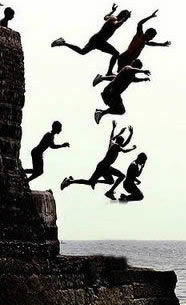
This known as being a lemming.
We keep doing dumb stuff because we take the babbling of our minds seriously.
For example, we condition themselves to blame others for our pain, and end up making matters worse. Our minds tell us to blame, and we blurt out words in keeping with blame.
In the past, doing this made the situation worse, so, just like lemmings, we run off the same cliff again.
You have to fully grasp that the stories our minds pop up for us are not true! They are not accurate! They are not even particularly interesting. All they are is repetitious, and designed to cause us suffering.
Now, you might wonder why our minds would want us to suffer.But this is not a helpful question.
It’s enough for us to notice that this is what happens. Our minds are not satisfied with “what is” — they’d rather bitch, moan and complain that things should be different.
Except that they never propose an alternative; rather, our minds encourage us to do again what never has worked.
So, back to “catching myself.”At the point of the “grab and crunch,”tweak of pain, a fork appears in my road. I could listen to the story my mind is shoveling, and prove my mind right.
Or, I can pause, turn my attention away from the chatter, and have a chat with my lower back.
In the choice to pause, and ask my body what it needs, I hear another, distinct, wise voice (of my body? Hmm. maybe. Distinct, though, and different…) saying,
“Stop right here. Hold. Now, go down to the ground, slowly, wiggle and check.”
If I compare the two voices,
the first, (the mind voice,) is all scream‑y and dramatic, hard done by, and just aching to prove that I will be suffering, and soon. The other (body?) voice is calm, reasonable; it invites me to experiment with myself in a calm and collected way, and then to judge actual results, without drama.Exercise: Pay attention to the workings of your mind. If you refuse to do this, you are doomed to be a suffering, unhappy, non-present drama queen until you die.
If you choose to shift (in addition to sitting Zazen, 20 ‑25 minutes a day…) do this:
Listen in on your mind. For example, you may say aloud or to yourself, “What a lovely day.” Immediately after, say, “This is my mind, describing how I perceive the day.” Or, shorthand, “Me, talking to myself.”
In dialogue with someone, you might notice yourself thinking “How dare she talk like that! Tell her what a jerk she is!” Stop. Breathe. Say to yourself,
“Me, having judgemental thoughts.”
Then, try asking questions instead of blaming.
The frenetic, dramatic voice your mind produces is basically full of crap. It prattles on about how special you are, about how everyone should treat you as important, about how hard done by you are.
It wants more of the good stuff, it rejects the bad stuff, and clings to its stories like a terrier on a bone. This voice is not you, is not accurate, and leads you, repeatedly, into deep water.
In order to come to terms with this voice, and thus to put it in its place, you must learn
to hear it, andto ignore it’s stupidities.Then, with a breath and a bit of mindfulness, another path will occur to you.
And this, the path less traveled by, makes all the difference. (with thanks to Robert Frost.)
Facebook TwitterJuly 18, 2021
Progressive Relaxation Technique
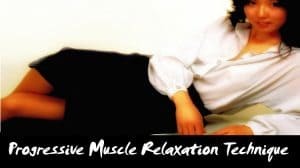 Progressive Relaxation Technique — an oldie but a goodie! The next few articles will be about getting into your body.Let’s have a look at several techniques for dealing with stress — all without drugs.
Progressive Relaxation Technique — an oldie but a goodie! The next few articles will be about getting into your body.Let’s have a look at several techniques for dealing with stress — all without drugs.Back when I was a therapist I was pretty well known for my aversion to drugs… and by that I mean “mind drugs.” I still get a bit incensed over the push to medicate, despite most of the drugs being of questionable effectiveness.
And then there’s the whole process of weaning people off of the drugs they become addicted to.
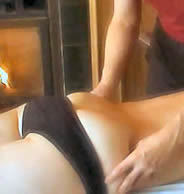
Because of my interest in Bodywork, of course my focus would be on the physical things we can do to deal with the effects of stress.
Wilhelm Reich, the father of Bodywork psychotherapy, was the first to grasp what people did with stressors.
He noticed what he called “character armour.” In other words, when stressed, people tighten their muscles, and soon, the acute tightening becomes “chronic.”
Bodywork provides a way out — using pressure on the “tightened part” creates the environment to “let the stressor go.” Not only do you discover how and where you “hold” stress, you also discover that even deeply held stress can be “dropped.”
Sadly, finding Bodyworkers is difficult.The good news is that you can get a handle on what your body is doing. In a second, I’ll walk you through an exercise you can try. But I also want to make a couple of Bodywork suggestions.
Alternatives to Bodyworkers:Deep tissue massage therapists (Rolfers, deep tissue): The Rolfers I’ve worked with really get in there. Best if you decide to to a “full round” or Rolfing, which involves multiple sessions.Acupressure: some acupressure people know about Bodywork — you’d have to ask around.“Regular” massage therapists: again, ask around. My experience has been mixed to negative, as even massage therapists who advertise as “deep tissue” really aren’t pushing all that hard.Lastly, “regular” massage therapists are NOT trained to deal with the emotions that arise from deep Bodywork. Most will immediately pull back. I’ve never come up with a solution for this.Progressive Muscle Relaxation TechniqueA video featuring the muscle relaxation techniqueThis muscle relaxation technique doesn’t require much exertion for it to be effective; that’s probably why it is so popular.
It works best on the type of muscular tension that causes body aches and headaches — pains that you have likely had for days; pains that may even have “gone background” — you might not even realize they are still there.
Progressive muscle relaxation uses subtle movements to relieve tension and to begin to relax. The method is based on the idea that it’s easier to relax muscles by making small movements.
By tightening each muscle group and then releasing it, you start to feel more relaxed and less stressed.It’s all about exaggerating each conscious “tightening and release” -– you become more aware of your muscles — more aware of when you’re holding tension. You then use the muscle relaxation technique to reduce your stress levels before the stress has a chance to get out of control.
How To Do Progressive Muscle RelaxationThe first step is finding a room to practice this – it should be relatively quiet, dimly lit, and you should be able to sit comfortably or lie down.Close your eyes and start breathing deeply through your nose. Hold your breath for just a few seconds and then release it through your lips. Do this several times, and imagine that your body is becoming heavy and warm. Release any tension that you become aware of.Continue to breathe slowly and clench both of your fists, then tighten your biceps and hold the tension for several seconds. Now release the tension and let it ebb away. Your focus should be on the changing sensations in your muscles. As you allow the tension to flow from your arms, hands, and fingers keep your hands open to shake off the remnants.Now, continue this pattern through each of the major muscle groups in your body.Face. Start by raising your brows and furrowing your forehead. Then squeeze your eyes closed as tightly as possible, and then clench your teeth. Finally, squeeze your face like a toddler would do after eating lemon for the first time. HOLD for five seconds, then slowly release.Neck. Slowly pull your chin toward your chest. Then turn your head to the right, then to the left, then back to centre. You should keep your shoulders relaxed but straight while you practice this technique. Tighten your neck muscles. HOLD for five seconds, then slowly release.Chest. Puff your chest out and take a deep breath. Tighten your entire chest. HOLD for five seconds, then slowly release.Shoulders. Shrug your shoulders, pushing them back for a few seconds, relax and then pull them forward. Roll your shoulders upward. HOLD for five seconds, then slowly release.Upper Back. You can either sit in a chair and allow your back to rest against the chair, or place a rolled up towel or bolster under your upper back. Push your body so that your upper back arches. HOLD for five seconds, then slowly release. (If this is uncomfortable or causes you pain then you should skip this one.)Abdomen. Pull your stomach in and then push it out, tensing it as though you were expecting a blow. HOLD for five seconds, then slowly release.Legs. Lift your leg and tense your calf and thigh muscles (prepare for cramping) and bring your toes toward you. Do each leg in turn first and then raise both of them before finally pointing your toes out as far as possible. HOLD each move for five seconds, then slowly release.Feet. Point your toes (all while keeping your legs down) and then pull them toward you before finally digging your feet into the floor. You should breathe deeply while you practice this exercise. HOLD for five seconds, then slowly release.As you work through each group of muscles, you will feel warmth enveloping your body as you finally relax.After you complete the exercise, take some down time and allow your muscles to rest. Just enjoy the relaxation before you rush back into action. You’re transitioning from total relaxation so you don’t want to undo your hard work by jumping up and diving back into your day.
While the total amount of time required to complete this exercise will vary from person to person it really doesn’t take much time at all. Remember to give yourself enough time to pause for 30 seconds between muscle groups, and to enjoy the peace once you have finished.
You may choose to do this in total silence, but relaxing music is an effective way to block out any background noise, which may break your focus.
Facebook TwitterJuly 3, 2021
Whole Being — Awareness as compared to Non-awareness
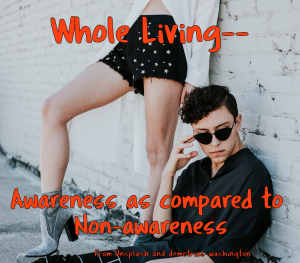
Awareness as compared to Non-awareness — not only is paying attention a challenge, what we miss far outweighs what we pay attention to. Nevertheless, it’s worth working toward more awareness.
 Psst! Hey!
Psst! Hey!** Want more great writing designed to help YOU to shift your behaviour?
** Want to learn how to find, build or deepen your principal relationship?
** Want to know more about Zen living and being?
Back before the pandemic, we decided to take Darbella’s mom out to Red Lobster for a belated birthday lunch. And, bonus, I could eat lobster!
So I did. And I really enjoyed it. And about half way through the meal I thought about being in Costa Rica, and how difficult it is to buy seafood, despite our living in a beach town.. And poof. There I was, gone — non-present. Un-aware.
A mundane example, for sure.But an ages-old issue for Buddhists of all stripes. Awareness can only be moment-by-moment, because now is all there is. Of course, now can include thinking about the future or ruminating about the past — so long as you are doing so consciously.
That’s one on the main reasons to meditate. Meditation, like nothing else, show us how easily diverted our minds are. Raising that diversion to consciousness is being awake.
And then, there’s the whole issue of how little we are aware of in the first place.Turns out that the mental process of perceiving, and perhaps to a greater extent, interpreting experience not only affects mood and motivation. It affects us at the cellular level.
Bruce Lipton is a development biologist who has been writing about this for decades. He writes that only 5% of dysfunction is genetic. The rest is the organism’s response to the environment.
Thus, –
For example, if an organism “perceives” a stress that is actually not there, the mis-perception can actually change the genes to accommodate the “belief.”
“Perceptions” lie between the environment and cell expression. If our perceptions are accurate, the resulting behavior will be life enhancing. If we operate from “mis-perceptions,” our behavior will be inappropriate and will jeopardize our vitality by compromising our health.
In other words, what we perceive, and more importantly, how we interpret what we perceive, is chiefly responsible for our health and well-being.
Today’s topic is awareness as compared to non-awareness. Another way of putting this is, the more aware we are regarding what we are thinking and how we are interpreting our experience, the healthier we are.
The more we “miss” (non-awareness), the more we think “stuff” is happening to us — we think we are governed by “stuff” that seems to be out of our control.
Simple, right? Well, not really. The question is: if awareness is crucial, what, exactly, are we aware of?Every second, the brain is being “hit” with 4 billion signals. Of those 4 billion signals, we are only aware of around 2000 bits of all that information.
Here’s a picture. Imagine it’s made up of 4 billion pixels.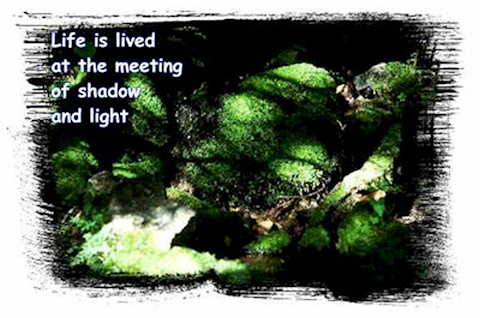 Now, let’s look at what the brain is actually conscious of. Remember, it’s 2000 bits. Here, the dot represents what we are conscious of at any given time.Except it’s enlarged 1000 times, so you can see it.
Now, let’s look at what the brain is actually conscious of. Remember, it’s 2000 bits. Here, the dot represents what we are conscious of at any given time.Except it’s enlarged 1000 times, so you can see it.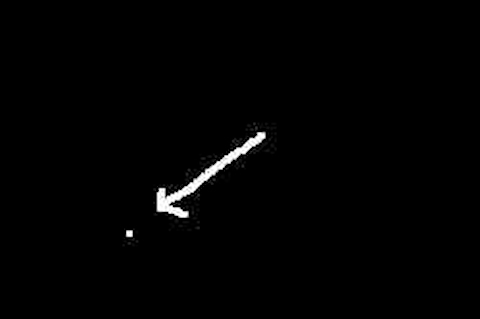
What this picture describes is this: we are un-aware of 99.999999% of the signals hitting our brains.
So, let’s imagine you want to shift a behaviour. You think about it and think about it. And you discover that nothing changes. Why?
Because the “reasons” for the behaviour are likely buried in the “missed signals.”Let’s do an experiment: answer me this — what does what your butt feel like, right now? Hadn’t been aware of your butt before I asked, had you? Despite the fact that your butt nerves were sending messages to your brain, your brain chose not to bring it into your awareness.
Until you chose to pay attention to your butt. You are what you attend to. All the rest is somewhere in the background.
Here’s the killer: The vast majority of your “rules and beliefs” about how to be are buried in the 99.999999% “cloud of un-awareness.”These are the things I call Rock beliefs in my book, Living Life in Growing Orbits. They are firmly fixed beliefs you created out of thin air. Once you made them, they faded into unconsciousness, yet continue to determine your behaviour, out of your consciousness.
If you are not aware of the belief, you can’t change it. Even when you become aware of it, changing a Rock, core belief is hard, hard work.
Lipton says something like, “The behaviour won’t change unless you change the core belief.” But… but… you have to be willing to dig deep and extract that core belief.
Let’s say you’re having trouble with your husband. You try different approaches: for example, you might decide to learn and use a communication model. But nothing much changes — the troubles continue.
This is a good sign that the real issue lies with one of your “core beliefs.”Perhaps, growing up, you decided that people should treat you “special.” Or, you learned you had to fight every time you felt threatened, in order to stay alive. Or you were taught that you had to get sick to get attention (this is a biggie!)
If a Rock belief is unconsciously driving your ship, no communication model in the world will help.
If you do not change the core belief, your day-to-day behaviours are not going to shift.
Period.
If the core belief remains out of your awareness, the only alternative the “system” (your body) has is to get your attention by making you sick or making you ache. If that doesn’t work, the cells begin to break down and you get deeper, more serious illnesses.
Awareness is the ability to focus your attention on what is really going on at the deep, core level. Bodywork deals with this same process, allowing core issues to emerge.
Un-awareness is thinking that your life is out of your control, as opposed to simply out of your consciousness.
Awareness is knowing what’s up at the core level. Unless and until you take core work seriously, nothing will change.
The good news is that what is in our cloud of un-awareness is simply unchosen data. It is available, so long as you are prepared to do the work of extracting it.Give my book, Living Life in Growing Orbits, a try. It’s 365 days doing the hard work of self-exploration, at the core level.
Facebook TwitterJune 26, 2021
Using a Zen Stick
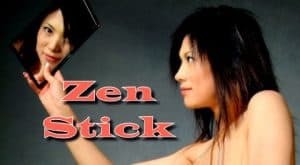
Synopsis: Zen Stick: sometimes, we need a smack upside our heads, metaphorically, of course.

If you want to figure out what’s going on with your life, you really need to check out my books.
Learn to sort out what you can do something about from what you can’t.
The Zen StickEvery Friday I get an e‑mail from Shambhala Publications, with a little Zen quote. I was going to write the “stick” article, and then, this quote showed up, which is sort of such a stick:
INWARD & OUTWARD VIEWS
To cling to oneself as Buddha, oneself as Zen or the Way, making that an understanding, is called clinging to the inward view. Attainment by causes and conditions, practice and realization, is called the outward view. Master Pao-chih said, “The inward view and the outward view are both mistaken.”
—Pai-chang
The Zen Reader (aff. link)
edited by Thomas Cleary, page 54
Interestingly, Master Pao-chih could have also said, “The inward view and the outward view are both correct.”
Now, about that stick. Whatever is she
Whatever is shetrying to tell me?
Zen is filled with stories of stuff like students being tossed out a window as a way to get them to wake up.
In some Zen Temples today, a person wanders around with a bamboo rod, and thwacks you across the shoulders if you slump or doze.
So that’s sorta my guidepost. Er. Stick.
But for me, it’s never physical. I prefer a good verbal thwock.
For Darbella and me, there’s,
“Or… you could get over yourself.”
This line, admittedly used more by Dar in my direction, is a reminder for those times when I wind myself up and start ranting. I’m caught in my own stew, and even after decades, that line does wonders.
I used this line with a friend the other day, who posted a link on Facebook: “46 Things to say to an anxious child.” I figured that was about 45 too many. Life isn’t a negotiation — you’re either awake, or not.
Friends reported being on a plane, and the flight attendant wanted the mom behind them to buckle up her 7 year old for landing.
Quoth the mom, “You’ll have to wait, I’m negotiating with her.”
Get out the Zen stick.
Which is all about cutting through the bull, and stating the obvious. And the obvious is always, “Deal with it. Stop telling yourself stories. Do something different.”
That’s really the point, too, with the above quote from Pao-chih.
His idea is that these two schools, inner and outer, are like any other division. As soon as you turn away from the actual thing, you’re missing the point.
If you pick a side, and then argue for the “rightness or correctness” of the view, maybe even giving your life for the perspective you hold, all you have is the description.
Now, of course, all of this can be confusing, because we are conditioned to try to “get it right.” The belief in right or rightness becomes a substitute for the actual thing. And we end up living our lives starving to death surrounded by food.
It’s like imagining eating a slice of pizza, as opposed to actually eating one.
Another Zen story goes, short version, that a Master spoke often on emptying your mind. A disciple said, “My mind is empty, now what do I do?”
The Master replied, “Drive it out! Get rid of it! Don’t stand there in front of me with nothing in your mind!
Get it?
The disciple’s mind was filled with thoughts of how empty his mind was — thoughts of how advanced he was, seeing that his mind was empty! Oops!
Caught by the thought. Trout on a line.

Looking for more on this topic? Check out my book, Half Asleep in the Buddha Hall.
As I said above, inner and outer are also both true and valid paths. The problem comes when you make one or the other the only path. “This is what I do” is helpful. “This is right…” not so much.
 The problem with
The problem with being a wishbone
Many are the people who get something in their heads — something someone told them, some belief or definition about themselves (or about how the world works) and all they have is grief and misery.
So, they build a fence, a wall, around the belief, and keep operating from within it, getting the same lousy results, feeling like crap, and nothing changes.
So, they try harder.
And harder.
And things get worse, and they still don’t get it.
The belief they hold is leading them to destruction. It doesn’t matter how well thought out the belief is. If it gets you lousy results, it is ineffective.
Zen stick.Stop it. Now! No excuses, no, “But… but… why can’t I have what I want?”
Answer: because chocolate ice cream is never going to become spaghetti.
No matter how difficult you make it, the only thing that will change a thing is to do something different. To stop thinking. To stop analyzing.
To act differently.It’s not inner or outer, right or wrong.
It’s “What shall I do, this time, to simplify, to get over myself, to act?”
Zen stick.Facebook Twitter


